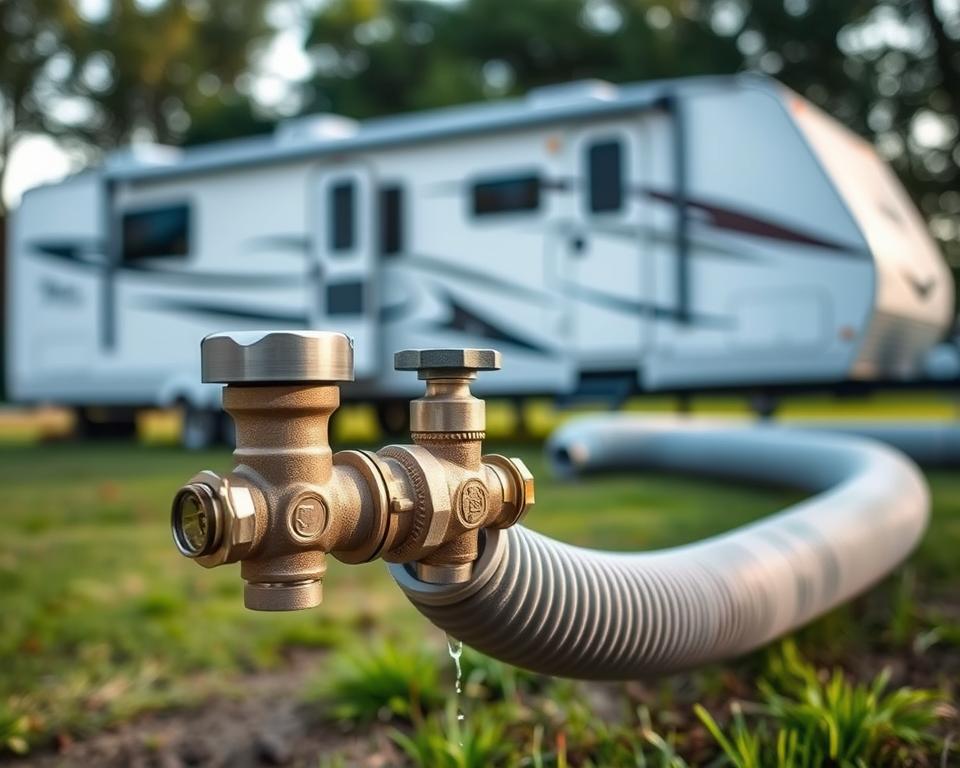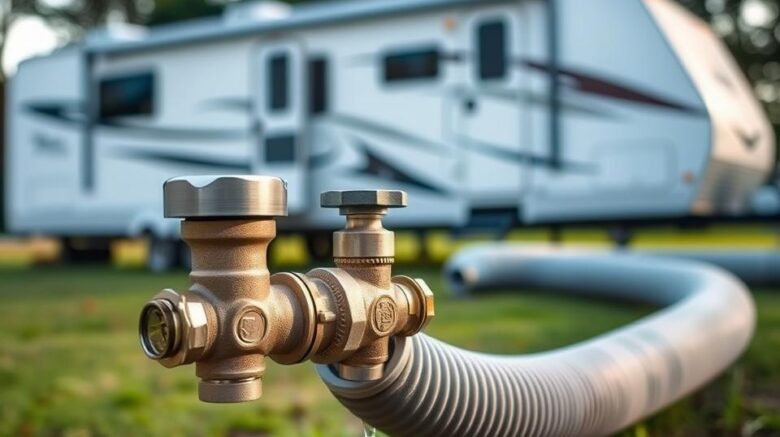Must-Know RV Septic Tank Service Care Tips
Have you ever considered what happens to your RV’s Septic tank as you’re on the road? It’s not just steering clear of bad smells. Maintaining your RV Septic tank well-maintained ensures hassle-free trips. A regularly serviced system prevents messy situations and costly expenses. Still, many overlook this critical care. Through this guide, we unpack the need for regular RV black water pump. We’ll highlight maintenance importance and offer tips for maintaining your recreational vehicle’s Septic tank. Prepare for worry-free trips!
Important Discoveries
- Consistent RV Septic tank service is critical for peak performance.
- Knowing your RV Septic system helps sidestep costly repairs.
- Routine maintenance prevents unpleasant odors and clogs.
- Create a pumping schedule suited to your usage.
- Use best practices for emptying your holding tanks.
- Steer clear of common mistakes to extend the life of your Septic system.
- Understand when to seek professional help for Septic services.
Understanding RV Septic Systems
An RV Septic system is essential for any camper. It contains multiple holding tanks that process waste efficiently. You’ll find three main tanks in an RV: the fresh water, the gray, and the black tank. The fresh water tank delivers clean water for drinking and cooking. Meanwhile, the gray tank stores wastewater from sinks and showers, ensuring cleanliness. The black tank, specifically for toilet waste, also has a vent to minimize odors.
Keeping a healthy camper sewage system requires recognizing how these parts interact. Frequent checks of the tank levels are vital to prevent overflow and ensure everything runs without a hitch. Getting to know the termination valves is key too. These valves are central in effectively handling waste disposal. By learning about these components, you can keep your RV in top condition and enjoy your travels without any unnecessary trouble.
| Reservoir | Purpose | Typical Size |
|---|---|---|
| Fresh Water Tank | Supplies drinking and cooking water | 30-100 gallons |
| Gray Tank | Stores wastewater from sinks and showers | 30-60 gallons |
| Black Tank | Stores toilet waste | 30-50 gallons |
Why Routine RV Septic Tank Service Matters
Consistent RV Septic tank service is central to keeping your system efficient and long-lasting. Without proper maintenance, you could face system failures, nasty scents, and pricey repairs—issues that interrupt your adventures.
Neglecting the upkeep of your RV’s Septic system may cause it to back up. This not only affects your RV’s function but also your comfort levels. A clean and regularly cleaned system is essential for smooth trips, granting you a serene travel experience.

Regular maintenance extends your sewage system’s lifespan and keeps a clean living space. Watching your Septic tank helps you detect issues early. This pre-planning saves costs and stress, granting you confidence during your journeys.
Ideal RV Septic Tank Pumping Schedule
Identifying the ideal schedule for RV Septic tank maintenance hinges on the vehicle’s usage. For those continuously on the road or staying in their RVs, it’s recommended to drain the black tank every 3–5 days. This practice ensures cleanliness and stops unexpected issues during voyages.
Weekend adventurers can usually wait until they return home to pump their Septic tank. Leaving waste in the tank too long, though, can cause build-up that hinders the tank’s function and smell control. It’s vital to check the tank’s level closely, get ready for disposal once it hits two-thirds full to keep everything running efficiently.
The capacity of your Septic system, along with how you use your RV, will guide when to pump. Being aware of these aspects boosts your RV’s performance and cuts the dangers of poor waste management.
| Usage Type | Recommended Pumping Frequency | Signs for Immediate Pumping |
|---|---|---|
| Frequent Usage | Every 3-5 days | Level reads 2/3 |
| Weekend Trips | After return home | Noticeable stench or sluggish flow |
| Extended Trips | Every 2-3 days | Gauge shows near full |
Best Practices for Emptying RV Holding Tanks
Efficiently managing a recreational vehicle’s holding tanks is essential for a pleasant camping experience. Always start by draining the black tank first. This approach allows the gray water to flow through and rinse out the hose. Be sure the use of a high-quality sewer hose for a tight connection and to cut spills. Once the tanks are emptied, completely flushing the black tank is important. Employing a built-in black tank flush or comparable alternatives can dramatically cut residue.
After the emptying process, it’s essential to close both valves tightly. This action is vital to keep a fully operational Septic system. Additionally, RV owners must utilize dump stations properly and adhere to local laws. Routine cleaning practices for recreational vehicle Septic tanks are necessary. They protect the system’s optimal functionality and avert future odors.
Preventing Odors and Clogs in Your RV
To manage odors and avoid clogs in your RV, being meticulous is key. The task begins with ensuring enough water in the holding tanks. Adequate water helps in breaking down waste properly, lowering bad smells.
Choosing suitable toilet paper is essential in this process. Opt for RV-safe toilet paper that dissolves quickly, avoiding clogs. This small adjustment considerably helps with maintaining seamless waste flow.
Using enzyme-based treatments can further improve waste decomposition and odor control. These natural solutions aid keep your RV smelling fresh. It’s also vital to regularly check vent pipes for obstructions to maintain good airflow and stop odors from infiltrating your living area.
RV Septic Maintenance: Mistakes to Avoid
Keeping your RV’s Septic system properly is essential for its effectiveness and longevity. When non-biodegradable items like wipes or feminine products are flushed, they can cause major blockages. These blockages can result in various problems that are difficult to resolve.
Not using enough water when flushing can also hurt the system. It creates waste buildup, resulting in bad odors and potential damage. Furthermore, a common mistake at full hook-up sites is leaving the black tank valve open. This lets waste to collect at the tank’s bottom.
Preventive measures entail consistently flushing and rinsing tanks after emptying them. Ignoring maintenance can escalate into significant issues requiring costly repairs. Being ahead of the game and knowledgeable safeguards both your RV and your finances.
Signs You Need Professional RV Septic Help
Recognizing when to seek professional RV Septic services is essential for preserving a healthy Septic system. Some indicators suggest the need for expert intervention. If you notice slow-draining tanks or smell persistent foul odors wafting from your RV, it is wise to act promptly. These signs often indicate underlying issues that need a thorough Septic tank service for resolution.
Visible leftover waste after emptying can also indicate problems within your Septic system. This situation may not fix with routine maintenance and may necessitate the use of specialized equipment. Professionals are ready to handle complex challenges using tools, such as high-pressure water jets, to deliver a comprehensive cleaning process.
Timely professional assistance can make a major difference. Minor issues can swiftly grow into more severe complications without proper care. Investing in professional RV Septic services preserves the integrity of your system and lengthens its lifespan.
| Warning Signs | Suggested Response |
|---|---|
| Slow draining tanks | Contact professional RV Septic services for assessment |
| Persistent foul odors | Schedule Septic tank service for diagnostics |
| Visible leftover waste | Seek immediate assistance from a professional |
| Frequent clogs | Consider expert cleaning solutions |
Long-Term Care for Your RV Septic System
Long-term care for RV Septic systems calls for attention past basic pump-outs. Doing deep cleaning of tanks every few months stops buildup and prolongs system life. Examining dump valve seals frequently stops leaks. Additionally, sanitizing the system maintains it clean and functioning well.
It’s important to monitor tank sensors to confirm they work correctly. Incorrect readings may lead to over-filling, affecting performance. Regular sensor checks and tweaking maintenance schedules can stop this problem.
| Action | How Often | Why It Helps |
|---|---|---|
| Deep Cleaning Tanks | Every 3-6 months | Stops residue accumulation |
| Inspect Dump Valve Seals | Monthly | Reduces risk of leaks |
| Sanitize System | Every 6 months | Controls bacteria |
| Monitor Tank Sensors | Monthly | Guards against overflow |
Preventive maintenance is key to your RV Septic system’s long-term health. It lays the groundwork for smooth and trouble-free travel experiences.
Why Choose All In Sanitation for RV Septic Needs
All In Sanitation stands out at providing RV Septic services that fit each client’s distinct needs. Whether it’s regular pump-outs or comprehensive tank cleaning, they get the essential role of a well-functioning Septic system in your RV’s performance.
Boasting extensive expertise in RV Septic systems, All In Sanitation provides top-tier guidance on maintenance and care. Their team is knowledgeable in the unique challenges RV owners face and provides effective solutions when troubles arise.
Choosing All In Sanitation lets RV enthusiasts dive in their journeys, leaving Septic concerns to a trustworthy ally. Their dedication to excellent service delivers tranquility and boosts the pleasure of adventures on the open road.
In Closing
Caring for your RV Septic tank is essential for smooth travels. It’s necessary to grasp your system and adhere to regular services. This secures you won’t face unexpected issues on your journey. These key steps cover frequent pumping and using sound waste management practices.
Efficient long-term care maintains your system in prime form. By using the provided maintenance tips, you can boost your travel experience. This method helps avoid expensive repairs later. Bear in mind, sidestepping common errors and knowing when to seek professional help are important.
Ultimately, being proactive in your RV Septic system’s maintenance guarantees a smooth adventure. It allows you to zero in on forming lasting memories. So, take these steps to heart and enjoy your road trips to their fullest.
